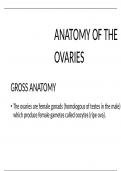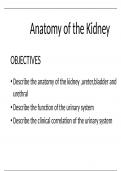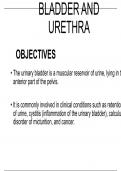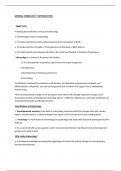Profliand
On this page, you find all documents, package deals, and flashcards offered by seller profliand.
- 69
- 0
- 5
Community
- Followers
- Following
1 Reviews received
74 items

ANATOMY OF THE OVARY
ANATOMY OF THE OVARIES GROSS ANATOMY • The ovaries are female gonads (homologous of testes in the male) which produce female gametes called oocytes (ripe ova). . Each ovary is about 4 cm long, 2 cm wide and 1 cm thick. • LOCATION • In nulliparous adult women, each ovary lies in the ovarian fossa on the lateral pelvic wall below the pelvic brim Cont… • The ovarian fossa is a slight peritoneal depression bounded: • Posteriorly by the ureter and internal iliac ...
- Summary
- • 56 pages •
ANATOMY OF THE OVARIES GROSS ANATOMY • The ovaries are female gonads (homologous of testes in the male) which produce female gametes called oocytes (ripe ova). . Each ovary is about 4 cm long, 2 cm wide and 1 cm thick. • LOCATION • In nulliparous adult women, each ovary lies in the ovarian fossa on the lateral pelvic wall below the pelvic brim Cont… • The ovarian fossa is a slight peritoneal depression bounded: • Posteriorly by the ureter and internal iliac ...

ANATOMY OF THE KIDNEY
Anatomy of the Kidney OBJECTIVES • Describe the anatomy of the kidney ,ureter,bladder and urethral • Describe the function of the urinary system • Describe the clinical correlation of the urinary system • Describe the embryological development of urinary system • Describe the histological components of urinary system Kidney • Synonyms: Renal (in Latin); Nephros (in Greek). • The kidneys are two bean-shaped, reddish-brown organs within the abdomen s...
- Summary
- • 64 pages •
Anatomy of the Kidney OBJECTIVES • Describe the anatomy of the kidney ,ureter,bladder and urethral • Describe the function of the urinary system • Describe the clinical correlation of the urinary system • Describe the embryological development of urinary system • Describe the histological components of urinary system Kidney • Synonyms: Renal (in Latin); Nephros (in Greek). • The kidneys are two bean-shaped, reddish-brown organs within the abdomen s...

ANATOMY OF THE GASTRO INTESTINAL TRACT
Peritoneum and Peritoneal Cavity Peritoneum has two layers: Parietal peritoneum lines the internal surface of the abdominopelvic wall Has the same blood, lymphatic vasculature and the same somatic nerve supply as is the region of the wall it lines Sensitive to pressure, pain, heat and cold, and laceration( pain is well localized) Visceral peritoneum Invests viscera organs Served by the same blood and lymphatic vasculature and visceral nerve supply as the org...
- Summary
- • 158 pages •
Peritoneum and Peritoneal Cavity Peritoneum has two layers: Parietal peritoneum lines the internal surface of the abdominopelvic wall Has the same blood, lymphatic vasculature and the same somatic nerve supply as is the region of the wall it lines Sensitive to pressure, pain, heat and cold, and laceration( pain is well localized) Visceral peritoneum Invests viscera organs Served by the same blood and lymphatic vasculature and visceral nerve supply as the org...

ANATOMY OF THE HUMAN ABDOMEN
The abdominal wall Encloses the abdominal cavity. Divided into anterolateral and posterior sections. The abdominal wall Functions Forms a firm flexible containment for the abdominal viscera in the abdominal cavity and assists the viscera in maintaining their anatomical position against gravity. Protects the abdominal viscera from injury. Assists in forceful expiration by pushing the abdominal viscera upwards. Involved in actions like coughing, vomiting, defecati...
- Summary
- • 130 pages •
The abdominal wall Encloses the abdominal cavity. Divided into anterolateral and posterior sections. The abdominal wall Functions Forms a firm flexible containment for the abdominal viscera in the abdominal cavity and assists the viscera in maintaining their anatomical position against gravity. Protects the abdominal viscera from injury. Assists in forceful expiration by pushing the abdominal viscera upwards. Involved in actions like coughing, vomiting, defecati...

ANATOMY OF BLOOD VESSELS AND TISSUES
Blood Vessels • Blood vessels are the components of the circulatory system that transport blood containing nutrients and oxygen to the tissues of the body. • They also takes waste and carbon dioxide away from the tissues. Five classes of blood vessels 1. Arteries 2. Arterioles 3. Veins 4. Venules 5. Capillaries. • Blood vessels are arranged into three concentric/circular layers or tunics • The three layers (tunics) are; 1. Tunic intima/int...
- Summary
- • 43 pages •
Blood Vessels • Blood vessels are the components of the circulatory system that transport blood containing nutrients and oxygen to the tissues of the body. • They also takes waste and carbon dioxide away from the tissues. Five classes of blood vessels 1. Arteries 2. Arterioles 3. Veins 4. Venules 5. Capillaries. • Blood vessels are arranged into three concentric/circular layers or tunics • The three layers (tunics) are; 1. Tunic intima/int...

ANATOMY OF THE URETHRA AND BLADDER
BLADDER AND URETHRA OBJECTIVES • The urinary bladder is a muscular reservoir of urine, lying in the anterior part of the pelvis. • It is commonly involved in clinical conditions such as retention of urine, cystitis (inflammation of the urinary bladder), calculus, disorder of micturition, and cancer. • Hence, its anatomy is of immense importance to clinicians. LOCATION • The urinary bladder is situated in the anterior part of the lesser pelvis immediately behind...
- Summary
- • 55 pages •
BLADDER AND URETHRA OBJECTIVES • The urinary bladder is a muscular reservoir of urine, lying in the anterior part of the pelvis. • It is commonly involved in clinical conditions such as retention of urine, cystitis (inflammation of the urinary bladder), calculus, disorder of micturition, and cancer. • Hence, its anatomy is of immense importance to clinicians. LOCATION • The urinary bladder is situated in the anterior part of the lesser pelvis immediately behind...

ADAPTATIONS OF THE RESPIRATORY SYSTEM TO ITS FUNCTIONS
Histological Adaptations of Respiratory system to its Functions General Organizational Pattern of Respiratory System Respiratory system is organized into the following layers; 1. Mucosa Layer • The respiratory mucosa is made up of the epithelium and supporting lamina propria (a thin layer of connective tissue) • Lamina propria contains elastin and collagen fibers, which provide the trachea with support and elasticity. NB/ Along the respiratory pathway, the epithelial lining changes t...
- Summary
- • 43 pages •
Histological Adaptations of Respiratory system to its Functions General Organizational Pattern of Respiratory System Respiratory system is organized into the following layers; 1. Mucosa Layer • The respiratory mucosa is made up of the epithelium and supporting lamina propria (a thin layer of connective tissue) • Lamina propria contains elastin and collagen fibers, which provide the trachea with support and elasticity. NB/ Along the respiratory pathway, the epithelial lining changes t...

Introduction to General Embrology
GENERAL EMBROLOGY 1 INTRODUCTION . OBJECTIVES • Introduction/Definition of Human Embryology • Terminologies Used in Embryology • To Understand Normal Human Development from Conception to Birth. • To Understand the Principle of Teratogenesis and the Basis of Birth Defects • To Understand the Developmental Basis in the Study and Practice of Medicine/Importance Embryology is a branch of Anatomy that studies; a) The development of gametes (sperm and ovum)/gam...
- Summary
- • 4 pages •
GENERAL EMBROLOGY 1 INTRODUCTION . OBJECTIVES • Introduction/Definition of Human Embryology • Terminologies Used in Embryology • To Understand Normal Human Development from Conception to Birth. • To Understand the Principle of Teratogenesis and the Basis of Birth Defects • To Understand the Developmental Basis in the Study and Practice of Medicine/Importance Embryology is a branch of Anatomy that studies; a) The development of gametes (sperm and ovum)/gam...

Gyanaecological Assessment
GYNAECOLOGICAL ASSESSMENT GYNAECOLOGICAL ASSESSMENT Reproduction and sexual issues are often considered extremely personal and private. Initiate rapport and develop trust with the client from the initial interaction in order to elicit such information. Be professional, and non judgmental Begin with less sensitive information and progress to sensitive issues. GYNAECOLOGICAL ASSESSMENT The gynecological assessment is divided into three; Health history Physical examinatio...
- Class notes
- • 58 pages •
GYNAECOLOGICAL ASSESSMENT GYNAECOLOGICAL ASSESSMENT Reproduction and sexual issues are often considered extremely personal and private. Initiate rapport and develop trust with the client from the initial interaction in order to elicit such information. Be professional, and non judgmental Begin with less sensitive information and progress to sensitive issues. GYNAECOLOGICAL ASSESSMENT The gynecological assessment is divided into three; Health history Physical examinatio...

Vaginal Cancer
VAGINAL CANCER Vaginal cancer refers to malignant cancer of the vagina. It is one of the rarest types of cancer affecting the female reproductive system It may be primary or secondary. Primary vaginal cancer arises for the vaginal tissues (squamous epithelium, glandular cells, underlying vaginal wall tissues). Secondary vaginal cancers usually occur as a result of spread of cancers from another part of the body, such as the cervix, uterus, vulva, bladder, bowel or other nearb...
- Class notes
- • 15 pages •
VAGINAL CANCER Vaginal cancer refers to malignant cancer of the vagina. It is one of the rarest types of cancer affecting the female reproductive system It may be primary or secondary. Primary vaginal cancer arises for the vaginal tissues (squamous epithelium, glandular cells, underlying vaginal wall tissues). Secondary vaginal cancers usually occur as a result of spread of cancers from another part of the body, such as the cervix, uterus, vulva, bladder, bowel or other nearb...

Driver's Ed: Chapter 7 Test Study Questions and Answers